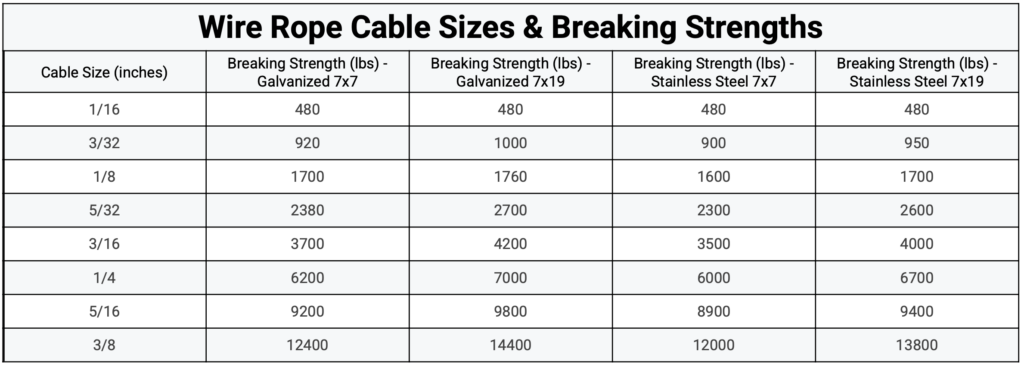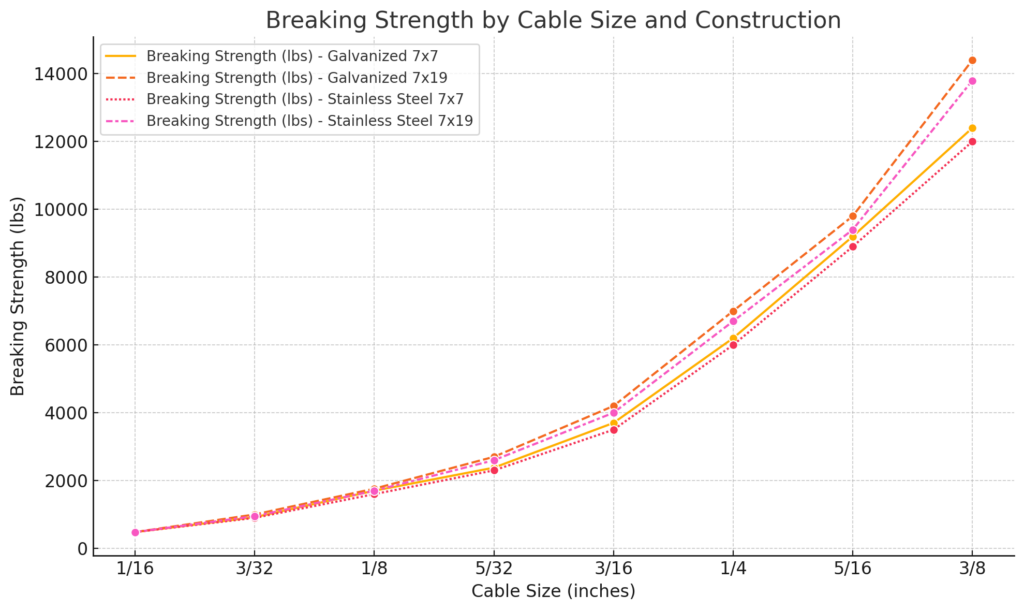Understanding Wire Rope Breaking Strengths
Breaking strength — also referred to as minimum breaking load (MBL) — is the maximum force a wire rope cable can withstand before it fails. It’s one of the most critical specifications in selecting the right cable for your application.
Key Factors That Affect Breaking Strength:
- Material
Stainless steel and galvanized wire ropes have slightly different tensile properties. Galvanized cable typically has a marginally higher breaking strength due to the properties of carbon steel, while stainless steel is chosen for corrosion resistance. - Strand Configuration
The construction pattern (e.g., 7×7 or 7×19) plays a major role. A 7×7 wire rope is more rigid and abrasion-resistant, while 7×19 offers greater flexibility but may exhibit slightly lower breaking strength per diameter. - Cable Diameter
Breaking strength increases with cable diameter. We provide detailed specifications for all cable sizes up to 3/8”, the maximum diameter we fabricate. - Coatings
While coatings like vinyl or nylon enhance abrasion resistance and longevity, they do not directly impact the steel cable’s internal strength. However, coating must be stripped before end fittings can be properly adhered

Terminations & Holding Strength
When swaging on end fittings like a wire rope stop, ball, or crimp sleeve, proper installation is essential. An end fitting that is professionally crimped is designed to maintain 100% of the cable’s rated breaking strength, assuming it’s matched with the correct fitting and cable type. This is often referred to as a cold weld — a term used to describe the secure, pressure-formed bond created during crimping. Here at Tyler Madison we have up to a 120 ton hydraulic swage machine and pull test every assembly line to ensure all assemblies hold to breaking strength
Wire rope clips, on the other hand, are not designed to hold full breaking strength unless properly installed in a double saddle configuration with precise torque values. They’re typically used for temporary assemblies or when adjustability is required. We cannot guarantee that installation in the field will be perfect, so we usually recommend that you consider having your assemblies made professionally in shop before looking to wire rope clips as an option.
Safety Factors
The working load limit (WLL) is not the same as breaking strength. Industry standards recommend applying a safety factor — often between 5:1 and 10:1 — depending on the risk, application, and environment.
For example:
- Lifting applications may require a 5:1 safety factor
- Life-safety or fall-protection systems may require 10:1 or higher

Need help choosing the right cable, coating, or termination?
Contact us for expert guidance and a custom quote
Request a Quote
Submit your info and basic project details and our qualified staff will contact you promptly to discuss your inquiry.
- Contact us by filling out the form
- We will be in touch to review & confirm
- Receive order
Contact Us
Ready to take the next step? Contact Tyler Madison for expert advice and custom cable solutions. Our team is eager to assist with any questions and to help you achieve your project goals with precision and care. Let’s work together to create something exceptional.
Prefer to speak directly? Give us a call, and our team will be happy to assist you right away.
